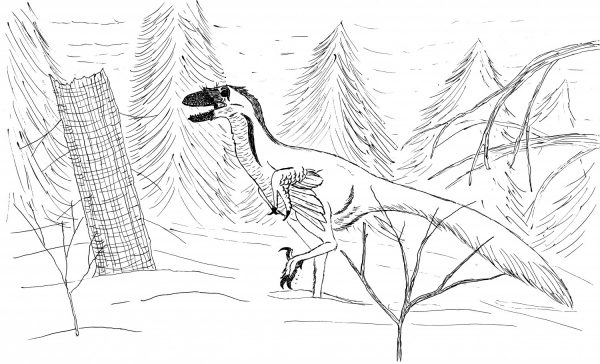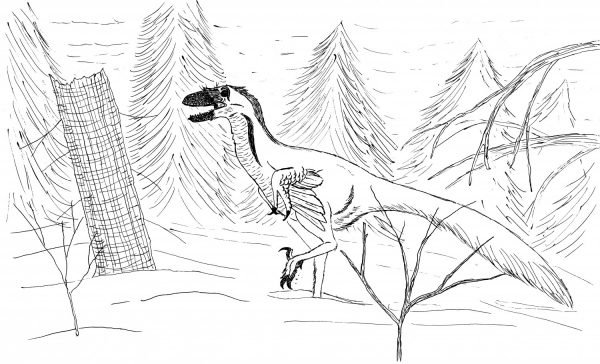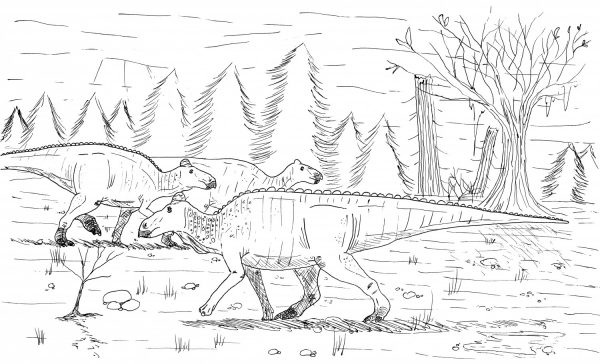
Dinosaur paleontology is full of apparent contradictions. One of the biggest of these is not only the very presence, but abundance, of these reptiles in and around Polar Regions. For animals long thought to have had metabolisms and bodies ill-suited for bearing the cold of prehistoric winters, the fact that a wide variety of dinosaur types are present in high latitudes has been making paleontologists question what they know about dinosaur biology and the Mesozoic climate for decades now.
Throughout much of the history of paleontology, dinosaurs have largely been found in mostly dry, temperate to tropical areas. This is probably more a reflection of where people spent most of their time looking than an indication of dinosaur distribution, as it’s much easier to look for fossils in places that are warm and dry. But when paleontologists started looking closer to the poles, they found dinosaurs there as well. Northern Alberta, Alaska, New Zealand, and Antarctica have all yielded prehistoric ecosystems rich in dinosaurs. The big question, then, is how did these animals exist at these latitudes? When we think of hardy polar animals, it’s more often things like furry, blubbery mammals that come to mind than Mesozoic reptiles. But the dinosaurs were there, so now we must reconcile what we find with what we thought we knew.
One thing that helps is the fact that the planet was quite a bit warmer back then than it is right now. Back in the late Cretaceous, for example, and the plains of western North America were flat, swampy delta along a vast inland seaway. The famous badlands of Alberta would have looked a lot like the bayous of modern Louisiana – a watery coniferous world teeming with crocodilians, lizards, turtles, and marsupial mammals. Summers were probably stiflingly hot and humid, winters were cool and frosty. Further north, ecosystems preserved in units like the Wapiti Formation were inland forests and floodplains, which experienced warm summers yet probably cooler winters. Up in Alaska, summers were likely cooler and winters possibly harsher, with at least modest amounts of snow. There’s also the daylight factor. With many of these areas being closer to the North Pole back then than they are today, northern dinosaurs had to deal with consistent darkness during the colder parts of the year.
Needless to say, this doesn’t sound like a terribly great environment for cold-blooded reptiles. Indeed, crocodiles, turtles, and lizards were abundant in the subtropical swamps of Cretaceous southern Alberta but much less common in the northwestern Wapiti Formation, and appear to be entirely absent from Alaskan rocks. These reptiles likely experienced some frost and perhaps light snow in places like (what is now) the Alberta badlands, something their modern relatives also face in places like the American south today. Since their fossils become less common to absent as you go north, it seems like the Cretaceous arctic was hostile to ectothermic animals.
So what can we discern about dinosaur biology and their prehistoric habitats from the fact that they lived in these seemingly hostile environments? First, there’s the ongoing debate over the metabolic rates and body coverings of different dinosaur lineages. As many will know, it was once believed that dinosaurs were ectothermic (or ‘cold-blooded’) animals, drawing most of their heat from their environment the same way modern reptiles do. The idea that the Mesozoic world was consistently warm and swampy and that dinosaurs were cold-blooded once seemed to support each other, but it’s more complicated than that.
Since the mid-70’s, paleontologists have been taking a skeptical look at dinosaur metabolisms, with some arguing that these animals were more like modern birds and mammals in that respect. It’s a topic we’re still arguing over, made all the more complicated by the overwhelming diversity of sizes and shapes in dinosaurs. An animal the size of a crow isn’t really going to work the exact same way as an animal the size of a whale, and dinosaurs spanned that whole gap. As it stands, many dinosaurs, especially larger species, are thought to be mesothermic, with different types falling somewhere along a spectrum between ‘warm-blooded’ and ‘cold-‘blooded’ (Reid, 1997). Some seemed to have been a little more similar to crocodiles and large turtles in their metabolic rates. Many small dinosaurs may have had similar, or even more or less the same, metabolisms as mammals and birds. This is supported by the fact that more and more small dinosaurs (and even a few modestly big ones) are being found with coverings of feathers or more primitive ‘dino fluff’ surrounding their bodies. Warm-blooded animals generally need some kind of insulation to keep the expensive heat they produce close to their bodies, and feathers are extremely good at this.
Being ‘warm-blooded’ with a coating of fluff would certainly have allowed small to medium-sized dinosaurs to tough out the winters. Some could possibly have taken to burrowing and/or hibernating to get by, as many species of mammals do today. That said, there isn’t much in the way of direct evidence of hibernation in dinosaurs. It’s worth remembering that areas that experience moderate to harsh winters today are still rich in dinosaur life. A trip through northern Alberta in the winter, for example, can lead to sightings of all sorts of feathered dinosaurs. Snowy owls, woodpeckers, gyrfalcons, chickadees, Snow Buntings, and Redpolls are just some of the species that do just fine in our winters despite the cold and narrower food availability. Were fuzzy hypsilophodonts and feathered troodontids capable of the same thing, picking out a living on small prey and winter plant matter in the cold dark? We aren’t sure yet, but it wouldn’t be surprising if they were.

A feathery troodontid prowls for food through the snow. By Nicholas Carter
Larger dinosaurs might be a whole other thing, though. Northern late Cretaceous rock units like Alberta’s Wapiti Formation and Alaska’s Prince Creek Formation are just starting to reveal the diversity of big dinosaurs in northern regions. Hadrosaurs, ceratopsians, and ankylosaurs make up the large herbivore fauna, with tyrannosaurs present as the main terrestrial predators. High-latitude summers with abundant plant life would have likely served these dinosaurs just fine, but winter was probably another matter. Either these animals were forced to travel to more favorable climates, or they were able to stick out the winter somehow. Let’s take a closer look at both of these theories.
Overland migration in large herbivorous dinosaurs has been suggested in the past, conjuring up analogous images of caribou migrating through the tundra or wildebeests crossing the Serengeti. One line of evidence that might support this idea is bonebeds. In Alberta, for example, there are many of these, mostly bonebeds belonging to duck-billed hadrosaurs and horned ceratopsians. To name a few, Dinosaur Provincial Park is littered with Centrosaurus apertus and Styracosaurus albertensis bonebeds, and the University of Alberta regularly excavates an Edmontosaurus regalis bonebed in the city that indirectly gave that dinosaur its name. The Peace country is well known for its Pachyrhinosaurus lakustai graveyard, plus another one possibly belonging to some other pachyrhinosaur (possibly P. canadensis, also known from a bonebed at Scabby Butte) and several hadrosaur bonebeds from at least one undetermined species. There’s also the Hilda mega-bonebed that covers vast swaths of southeastern Alberta and appears to be one colossal Centrosaurus bonebed. All of this is good evidence that these species travelled in large to enormous herds which were occasionally wiped out in terrible environmental disasters.
Paleontologists have wondered for years now if these massacred herds of big herbivores had been in the middle of migrating from one region to another when they were struck down by the forces of nature. This phenomenon is already known to happen to big herds of migrating caribou and antelope, with vast herds of these unfortunate animals being swept up in flooded rivers while moving to seasonal grazing areas. That said, it’s really hard to prove whether or not big herbivorous dinosaurs were really migrating over long distances or just moving around over a relatively static distribution. Paleontologists have taken a close look at the anatomy of polar dinosaurs to look for clues as to whether or not they were even capable of such a feat. While some big herbivores like the relatively spry hadrosaur Edmontosaurus seem to have been capable of travelling over at least moderate distances on a seasonal basis, but for other families like the bulkier ceratopsians and tank-like ankylosaurs it’s more uncertain (Bell & Snively, 2008). While dinosaurs were certainly not big lazy slugs, most just didn’t have the anatomical hardware that allow modern hoofed mammals to walk long distances with fairly minimal effort. That also goes for big tyrannosaurs as well, who were built more like giant flightless birds.

A herd of Edmontosaurus regalis wanders the northern plains during the cooler months. By Nicholas Carter, based on skeletals by S. Hartman and G. S. Paul
Finding remains of the same dinosaur species in both southern and northern regions, dating back to basically the same period of time, would give a lot of support to the migration idea. Things get confusing here though, since with some dinosaurs we have what looks like the same genus found in both northern and southern areas, but we don’t know yet if they’re the same species. Using the dinosaur-y province of Alberta as an example once again, the hadrosaur Edmontosaurus regalis, the horned dinosaur Pachyrhinosaurus canadensis, and tyrannosaur Albertosaurus sarcophagus are found in the southeastern badlands, in rocks about 73 million years old. Head northwest a ways, and you’ll find Edmontosaurus regalis and Albertosaurus sarcophagus in the Edmonton river valley. Go further northwest still, just past Grande Prairie, and in rocks of the same age you’ll find Edmontosaurus and Pachyrhinosaurus remains (Bell et al., 2013)(Fanti et al., 2007).. Starting to look promising for migration, don’t you think? But wait- we aren’t completely sure yet if these are the exact same species found further south. We’ve got tyrannosaur teeth up north too, but no bone yet with which to identify what kind of tyrannosaur. Despite the abundance of northern dinosaurs, only a handful have been identified down to the species level so far. We’ve got our wonderful Pachyrhinosaurus lakustai bonebed sure, but it’s older, and the only animals identified there have so far been found nowhere else. The fauna of the Prince Creek Formation of northern Alaska doesn’t make things much clearer- though it also contains tyrannosaur, pachyrhinosaur, and (depending on who you talk to) edmontosaur remains, the exact species found here seem to be unique to this location only (Fiorillo & Gangloff, 2000)(Fiorillo & Tykoski, 2012)(Mori et al., 2015). Dinosaur distribution over time and space is much less clear than we wish it was.

An Albertosaurus, desperate for food during the winter, attacks an Edmontonia. Again, it’s all hypothetical. By Nicholas Carter, based on skeletals by G. S. Paul
If migration is out, somehow these larger dinosaurs must have been able to survive the winter where they were. If this was the case, it’s tricky to imagine how they stuck out the winter. Dinosaurs like tyrannosaurs might have been okay, surviving off whatever they could catch with a potential insulating coat of feathers to keep them warm. But as far as big herbivores, so far our knowledge of their coverings is scales only. While scaly skin impressions is mostly documented from southern locations, a beautifully preserved Edmontosaurus found near Grande Prairie a few years ago also shows nothing but scales (Bell et al., 2013).. Primitive ceratopsians like Psittacosaurus have been found with strange keratinous bristles Mayr et al., 2002), but we’re lacking evidence of this or anything more substantial for keeping warm in big horned dinosaurs. While it’s feasible that they may have developed some kind of shaggy coat, and some paleontologists like to paint and draw them as such, we just don’t have the evidence yet. And we’re completely lacking fuzzy armored dinosaurs, primitive or derived. How would a big, slow ankylosaur deal with the chill of winter? Hard to say. Even if these big herbivores had mammal-like metabolisms, not having some kind of insulation would have probably been a problem. Perhaps, like elephants, species dwelling in northern regions (think mammoths) had thick fuzzy coat that their southern cousins lacked. We just can’t tell for sure yet.
There’s a case to be made that, just maybe, the polar Cretaceous climate wasn’t quite as cold as once thought. As small reptiles begin to be discovered in places like northwestern Alberta, we might have to re-think our knowledge of the Mesozoic arctic as well as the dinosaurs that lived there.
There’s lots of strong opinions and speculation on the prehistoric poles and the creatures that inhabited them. We’ve barely even touched on the dinosaur fauna of the other side of the world from places like New Zealand and Antarctica, which would have been met with similar challenges. What’re your thoughts on dinosaurs in the frost?
By Nicholas Carter
References:
Bell, P. R.; Fanti, F.; Currie, P. J.; Arbour, V.M. (2013). “A Mummified Duck-Billed Dinosaur with a Soft-Tissue Cock’s Comb”. Current Biology. 24 (1): 70–75.
Phil R. Bell & Eric Snively (2008) Polar dinosaurs on parade: a review of dinosaur migration, Alcheringa, 32:3, 271-284, DOI: 10.1080/03115510802096101
Burns, Michael & Coy, Clive & Arbour, Victoria & Currie, Philip & Koppelhus, Eva. (2014). The Danek Edmontosaurus Bonebed: new insights on the systematics, biogeography, and palaeoecology of Late Cretaceous dinosaur communities. Canadian Journal of Earth Sciences. 51. v. 10.1139/cjes-2014-0217.
Chinsamy, A.; Thomas, D. B.; Tumarkin-Deratzian, A. R.; Fiorillo, A. R. (2012). “Hadrosaurs were perennial polar residents”. The Anatomical Record. online preprint (4): 610–614
Fanti, Federico; Currie, Philip. J.; Burns, Michael E. Taphonomy, age, and paleoecological implication of a new Pachyrhinosaurus (Dinosauria: Ceratopsidae) bonebed from the Upper Cretaceous (Campanian) Wapiti Formation of Alberta, CanadaCan. J. Earth Sci. 52: 250–260 (2015)
Fiorillo, Anthony R.; Gangloff, Roland A. (2000). “Theropod teeth from the Prince Creek Formation (Cretaceous) of Northern Alaska, with speculations on Arctic dinosaur paleoecology”. Journal of Vertebrate Paleontology. 20 (4): 675–682.
Anthony R. Fiorillo and Ronald S. Tykoski (2012). “A new species of the centrosaurine ceratopsid Pachyrhinosaurus from the North Slope (Prince Creek Formation: Maastrichtian) of Alaska”. Acta Palaeontologica Polonica. 57 (3): 561–573.
Mayr, G.; Peters, S. D.; Plodowski, G.; Vogel, O. (2002). “Bristle-like integumentary structures at the tail of the horned dinosaur Psittacosaurus” (PDF). Naturwissenschaften. 89 (8): 361–365
Mori, Hirotsugu; Druckenmiller, Patrick S.; Erickson, Gregory M. (2015). “A new Arctic hadrosaurid from the Prince Creek Formation (lower Maastrichtian) of northern Alaska”. Acta Palaeontologica Polonica. 61.
Reid, R.E.H. (1997). “Dinosaurian Physiology: the Case for “Intermediate” Dinosaurs”. In Farlow, J.O.;
Brett-Surman, M.K. (eds.). The Complete Dinosaur. Bloomington: Indiana University Press. pp. 449–473.

